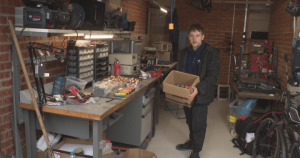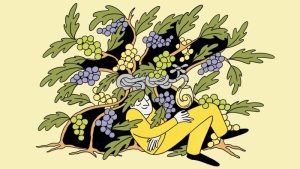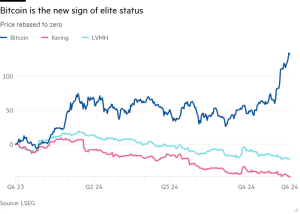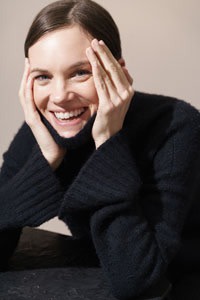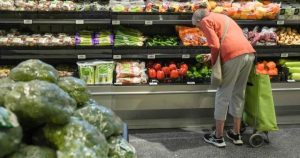Salt Lake City moves with the times
In 1856, Glasgow-born Elizabeth Ruth Caldwell Wallentine froze the toes on one of her feet during the infamous Willie handcart expedition, marching with her family on the long trek to Utah, which began tragically late in the season. She was just 12.
She left no first-hand record as to how she felt about it, but I remember gazing at her dour photograph in the Daughters of the Utah Pioneers Museum as a child and admiring my great-great-great-grandmother’s apparent resilience, which was subsequently enshrined in our family’s lore (what youthful grievance could compare?). My grandfather recounted that she would sometimes take off her sock to astonish her grandchildren.
A sentimental bronze statue of a family of handcart pioneers — man, woman, child — stands today in Salt Lake City’s central Temple Square, a central image of the Church of Jesus Christ of Latter-Day Saints (LDS)’s traditional iconography of faith and self-sacrifice. Spurred west by anti-Mormon hostility and the vision of a promised land, the Church’s followers first arrived to settle in the Salt Lake Valley in 1847 — though the Native American Shoshone, Goshute, Ute and Paiute inhabited the area for hundreds of generations before LDS pioneers rolled in.
Upon seeing the valley, LDS leader Brigham Young is said to have declared, “This is the right place” — popularly shortened to “This is the place”, as in the refrain of Utah’s current state song. They anchored the city with a temple and laid rigid grids of streets through the valley to form the industrious capital of the future “Beehive State”. The state legislature was and remains LDS-dominated, which has driven Utah’s historically conservative policies and laws around liquor, gambling, abortion, gay rights and women’s rights. The latter ranked 50th in a recent report analysing 17 key indicators of gender equality.

But Salt Lake City is not what it once was, nor even what many imagine it to be now. While I live on the west coast, I’m back regularly to visit family and witness its evolving character each time. In 2023, basketball commentator Charles Barkley dunked on the city — metaphorically — during the NBA All-Star Game: “Ain’t nothing to do in this boring-ass city . . . Can’t smoke, can’t drink. These people going to heaven,” he said. (Active members of the LDS church refrain from alcohol and tobacco.)
Barkley’s comments sparked local furore, with retorts that included billboards cheekily advertising the “Boring-a** city” alongside photos of the high-octane mountain sports that are another key part of Salt Lake’s culture in the adjacent Wasatch Range. For anyone who’s been around enough to know that the “Zion Curtain” liquor law has been repealed — let alone what a Zion Curtain is — there’s a lot more to the city’s story.
The LDS church retains its historic and cultural influence, but Salt Lake City also embodies many of the US’s current political and social contrasts, with a diversifying, ever-more-progressive urban centre at the heart of a determinedly red state. The Zion Curtain, which partitioned the view of the bar in restaurants to shield the eyes of the underaged, fell in reform legislation in 2017. In 2018, the city’s LDS-identifying population dropped below 50 per cent for the first time. While the area remains predominantly white, the Latino community grew to comprise 20 per cent of Salt Lake County in 2023.

Miles Waltman, executive vice-president of Lowe Property Group, a Salt Lake City-based developer, has witnessed “dramatic change in the last 10 years”, he says. “It’s not sleepy Salt Lake any more.” Lowe was a partner in developing the ambitious, mixed-use “Post District” that opened last year on a 13-acre site, which includes four “apartment communities”. They range from compact studios in 801 Flats (a reference to the area code and the local salt flats) to the vaulted ceilings and oversize windows of the upmarket The Register. Available 2-bedroom apartments to rent are listed for between $2,430 and $5,489 per month.
The past few years have also seen net migration to Utah, which has been attributed to an increase in local tech jobs (Adobe opened a branch office here in 2009, and training company Pluralsight and cloud software provider Domo both originated in the valley), the rise of remote work during the pandemic and the appeal of the outdoors; 10 ski resorts lace the Wasatch.
“We’ve seen a ton of people coming in from out of state,” Waltman notes, adding that this trend included almost every resident who moved into Lowe’s Dixon Place complex in Sugar House on its completion in early 2022. “It’s definitely a larger contingent of younger, working professionals,” he says.
However, this rapid development has also posed problems for some longer-term residents pushed out of once affordable areas by gentrification. The city’s 2022 Thriving in Place report found that half of renter households were rent burdened (spending over 30 per cent of their income on housing), and 81 per cent of respondents were concerned about displacement. The local real estate market was extremely hot during the first phase of the pandemic, says Christian Jacobsen, managing broker of Utah Property Finder. Real estate prices have come down about 5 per cent from the pandemic peak, Jacobsen estimates, but are still 40 per cent higher than pre-pandemic levels.

As US mortgage rates increased over the last couple of years, Jacobsen says he has seen what he calls a “soft market” in Salt Lake City. But, with rates starting to fall this past summer, “Maybe things are starting to pick up a little,” he adds, citing a 19 per cent increase in listings and an 11 per cent increase in under-contract homes compared to 2023. He has seen “slight appreciation over the past year” of around 1.5 per cent, with established neighbourhoods on the city’s west side — Sugar House, East Bench, and Millcreek — retaining their value in the market over the long term.
The change of mood and energy of the past few years is palpable: today’s Salt Lake City has a queer bookstore, more than a dozen each of local craft breweries and distilleries, and a bubbling creative ethos evinced in the annual Utah Arts Festival and the Salt Lake City Arts Council’s robust programming. The annual Utah Pride Parade has drawn estimated crowds of 100,000, and local LGBTQ+ non-profit Encircle has recently extended its open homes and mental health services into surrounding counties.
Research from Brigham Young University shows that Utah saw the fourth largest political shift leftward among US states between 2000 and 2020 — though it’s still easy to drive through the city and spot the differences between the rainbow flag-laden Marmalade and Sugar House neighbourhoods, and more conservative, manicured lawn suburbs south of the city, such as Lehi and American Fork.


TV personality and fashion designer Tan France of TV shows Queer Eye and Next in Fashion is arguably Salt Lake City’s most famous contemporary resident. He described in his 2019 memoir, Naturally Tan, how he fell in love with the city and then his husband there. “The city was gorgeous, and the people were so, so friendly. I knew that I eventually wanted to call this place home. Don’t ask me why . . . unless you seriously want a very long, drawn-out love letter to Salt Lake City,” he wrote of his first visit.
As someone who speaks out about colourism, racism, homophobia and Islamophobia, France arguably represents the modern version of Salt Lake far more than reality TV shows like The Secret Lives of Mormon Wives, which pander to audiences’ prurient interest in Mormon culture.
Project manager Bikram Singh moved to Salt Lake from New York City in 2021. Having previously visited between 2015–2017, Singh says that on his return, “I was stunned by the rapid growth happening all around.”
“As a turban-wearing Sikh, I’ve always felt safe and welcomed here,” he adds. Early on, “my wife and I visited the local Sikh temple, only to find the parking lot completely full — a sign of the flourishing South Asian community.” In addition to a gurdwara, there are now two Hindu temples in the valley, too. Singh also has frequent gigs as a DJ and dhol drummer for Indian wedding ceremonies — including mine last year.
A few generations in, my ancestors left the LDS church; I was raised Catholic and married in a Hindu ceremony in Salt Lake. My own family history speaks to the city’s continued evolution.

Any brief generalisation of Salt Lake will probably fail to capture the essential tensions of its parallel, overlapping, intertwined cultures: outdoorsy and settled, religious and accepting, insular and wide-open to business growth (it is frequently ranked among the top states for business).
Its biggest challenge now is arguably how the climate crisis will play out in its distinctive landscape. The valley’s poor air quality is a result of the natural inversion effect trapping pollution along with cool air in the lower-altitude area; managing this and the alarmingly low water levels of the Great Salt Lake are paramount. As water levels decline, the exposed lake bed can increase the circulation of dust particles and heavy metals, which exacerbates the poor air quality and poses a danger to public health. Conservation efforts are under way to restore the lake to “healthy” levels.
Amid all the complexities of the city nestled at its foothills, the rugged skyline of the Wasatch still beckons whenever I return. In a new form, this is still the place.
Find out about our latest stories first — follow @ft_houseandhome on Instagram
#Salt #Lake #City #moves #times
